From adrenaline-pumping races to fiery explosions, some festivals around the world are known for their unique blend of tradition and thrill. These events, often rooted in historical and cultural practices, draw participants and spectators alike for their daring and sometimes perilous activities. While many celebrate the spirit of adventure and community, they also come with inherent risks that make them stand out as some of the most bizarrely dangerous festivals on the international stage. Here, we explore ten such festivals where the line between celebration and danger is intriguingly blurred.
10. Running of the Bulls (Spain)
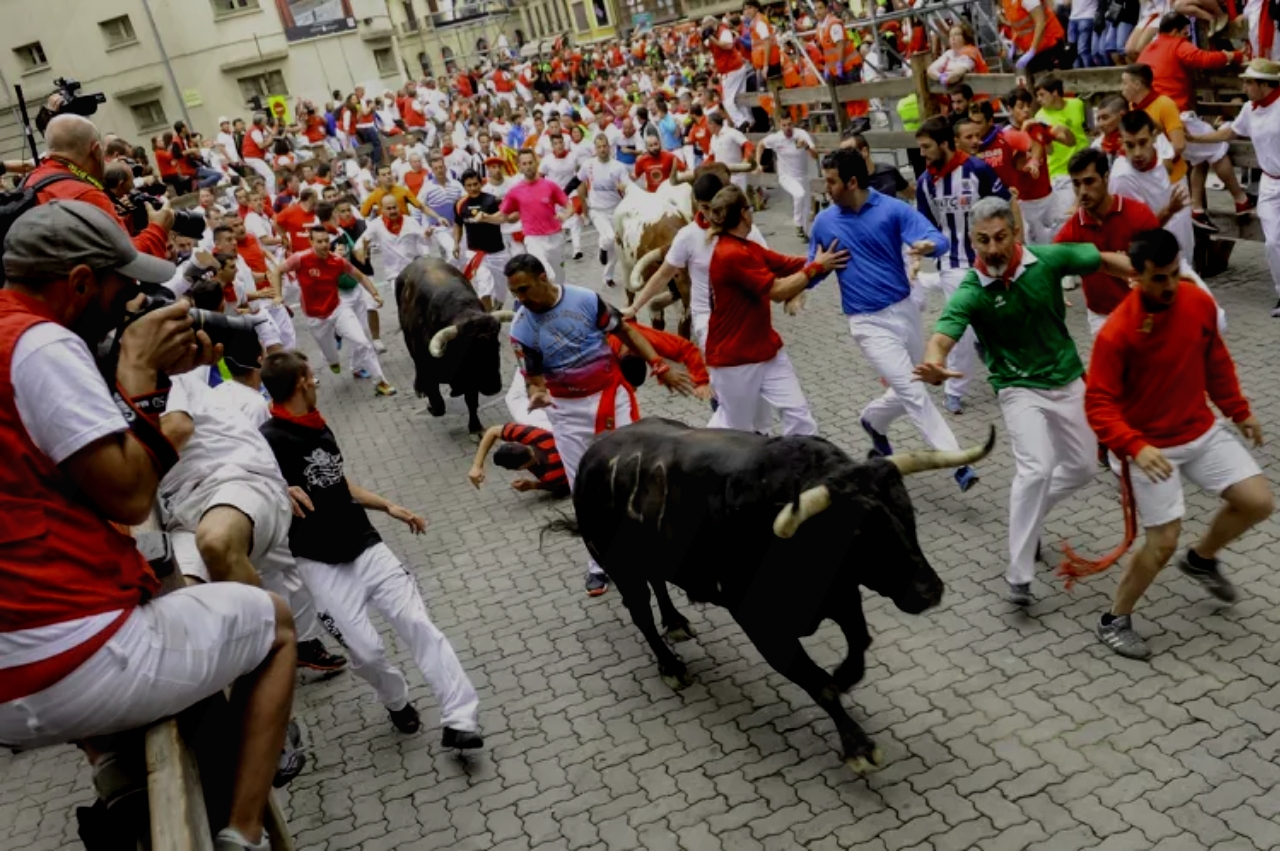
The Running of the Bulls, or “Encierro,” is a thrilling and hazardous event held annually in Pamplona, Spain, as part of the San Fermín festival. Taking place every July, it involves hundreds of participants sprinting through the narrow streets of the old town, pursued by a group of six powerful bulls. The event begins early in the morning with a rocket launch, signaling the release of the bulls from their pens. The run covers a distance of approximately 875 meters (half a mile) and ends in the city’s bullring.
Originating from the practice of herding bulls from the countryside to the city for bullfights, the event has grown into a globally renowned spectacle, attracting both locals and tourists. However, it is not without danger. The combination of excited crowds, slippery cobblestones, and charging bulls results in numerous injuries each year, ranging from minor bruises to serious gorings. Despite the risks, the Running of the Bulls remains a symbol of bravery and tradition, drawing thrill-seekers from around the world to test their courage in this exhilarating and perilous festival.
9. Cooper’s Hill Cheese Rolling (England)
Cooper’s Hill Cheese Rolling, held annually on the last Monday in May near Gloucester, England, is one of the most eccentric and dangerous festivals in the world. This daring event takes place on the steep and uneven slopes of Cooper’s Hill, where participants chase a seven to nine-pound round of Double Gloucester cheese down the hill. The objective is simple: be the first to cross the finish line at the bottom of the hill, ideally catching the cheese along the way. However, with the cheese reaching speeds of up to 70 miles per hour, it is almost impossible to catch.
The origins of Cheese Rolling are shrouded in mystery, with some believing it dates back to Roman times or ancient pagan rituals celebrating the arrival of spring. Despite its historical roots, the event’s modern incarnation is renowned for its chaos and the high risk of injury. The hill’s 200-yard descent, coupled with its steep gradient and uneven surface, often results in participants tumbling uncontrollably, leading to a myriad of injuries, from sprains and bruises to broken bones and concussions.
Medical teams and volunteers are always on standby to assist the injured. Despite the dangers, the event continues to attract thrill-seekers from around the world, all eager to participate in or witness the mayhem. The festival has grown in popularity over the years, drawing a large crowd of spectators who come to cheer on the brave souls daring enough to take on the hill. Cooper’s Hill Cheese Rolling is a testament to the enduring human spirit of adventure and tradition, wrapped in a uniquely British sense of humor and eccentricity.
8. Yanshui Beehive Fireworks Festival (Taiwan)
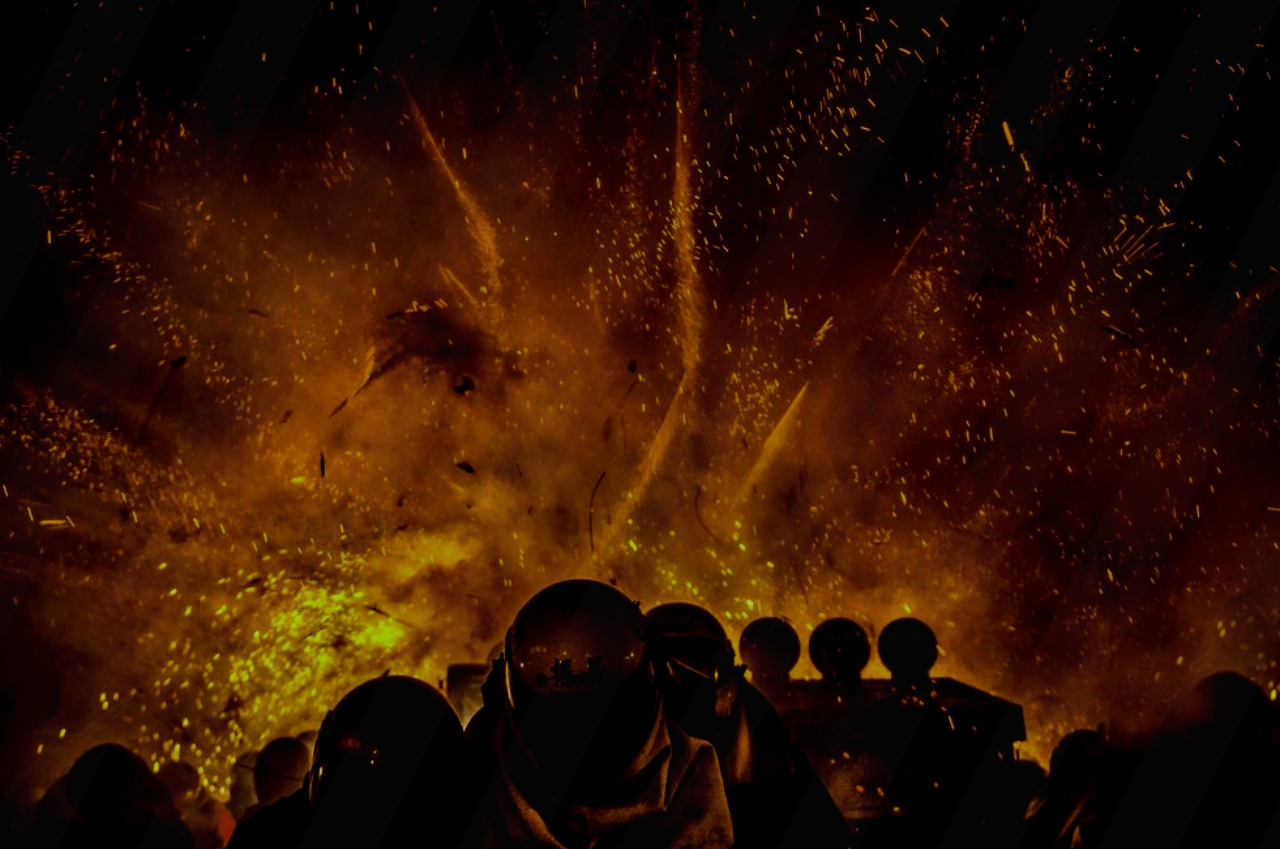
The Yanshui Beehive Fireworks Festival, held annually in Yanshui District, Tainan, Taiwan, is renowned as one of the most exhilarating and perilous festivals in the world. Taking place during the Lantern Festival, it dates back to the 19th century when residents sought to drive away a cholera epidemic by setting off fireworks to honor Guan Di, the Chinese god of war.
The festival’s main attraction is the “beehive” firework display. Massive wooden structures, or “beehives,” are loaded with thousands of bottle rockets and firecrackers. As night falls, these beehives are ignited, unleashing a barrage of pyrotechnics in every direction. Participants, dressed in protective gear such as helmets, thick clothing, and gloves, stand amidst the flying rockets, which create an intense and chaotic atmosphere. The experience is both thrilling and terrifying as participants are bombarded by sparks and explosions, creating a spectacle of light and sound.
Despite the obvious dangers, the festival attracts thousands of visitors each year. Injuries are common, with burns and other wounds treated by on-site medical personnel. The Yanshui Beehive Fireworks Festival is celebrated for its blend of tradition, communal spirit, and sheer adrenaline, offering a unique and unforgettable experience. It serves as a testament to the local belief in the power of ritual and the community’s resilience and courage in the face of danger.
7. Thaipusam (Malaysia)
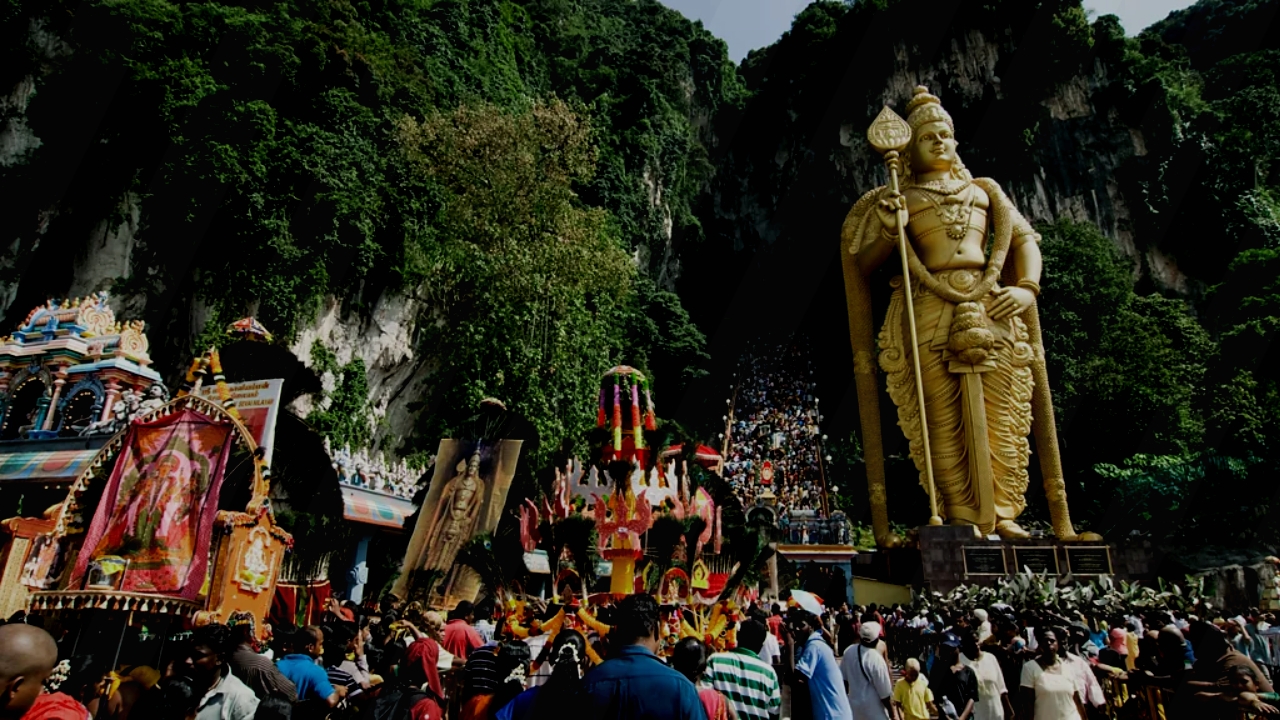
Thaipusam, celebrated primarily in Malaysia, is a Hindu festival that honors Lord Murugan, the god of war. Held during the full moon in the Tamil month of Thai (January/February), it is one of the most dramatic and intense religious festivals in the world. The festival’s centerpiece is a procession to the Batu Caves near Kuala Lumpur, where devotees demonstrate their devotion through elaborate acts of penance and self-mortification.
Participants prepare for weeks, undergoing a strict vegetarian diet and daily prayers to purify themselves. The rituals begin with devotees carrying kavadis, which are ornate structures adorned with peacock feathers and flowers. These kavadis are attached to the body with hooks, skewers, and spikes pierced through the skin, cheeks, and tongue. Some devotees pull heavy chariots with hooks attached to their backs, all while walking barefoot over several kilometers.
The festival’s roots lie in the legend of the goddess Parvati giving her son, Murugan, a spear to vanquish the demon Soorapadman. Thaipusam commemorates this event, symbolizing the triumph of good over evil.
Despite the extreme nature of these acts, injuries are surprisingly rare, attributed to the spiritual fervor and trance-like state of the participants. Medical teams are present to ensure safety, but many devotees believe that their faith and devotion protect them from harm. Thaipusam is a profound display of religious devotion, cultural heritage, and community spirit, attracting thousands of participants and spectators who witness the remarkable acts of endurance and faith.
6. Boryeong Mud Festival (South Korea)
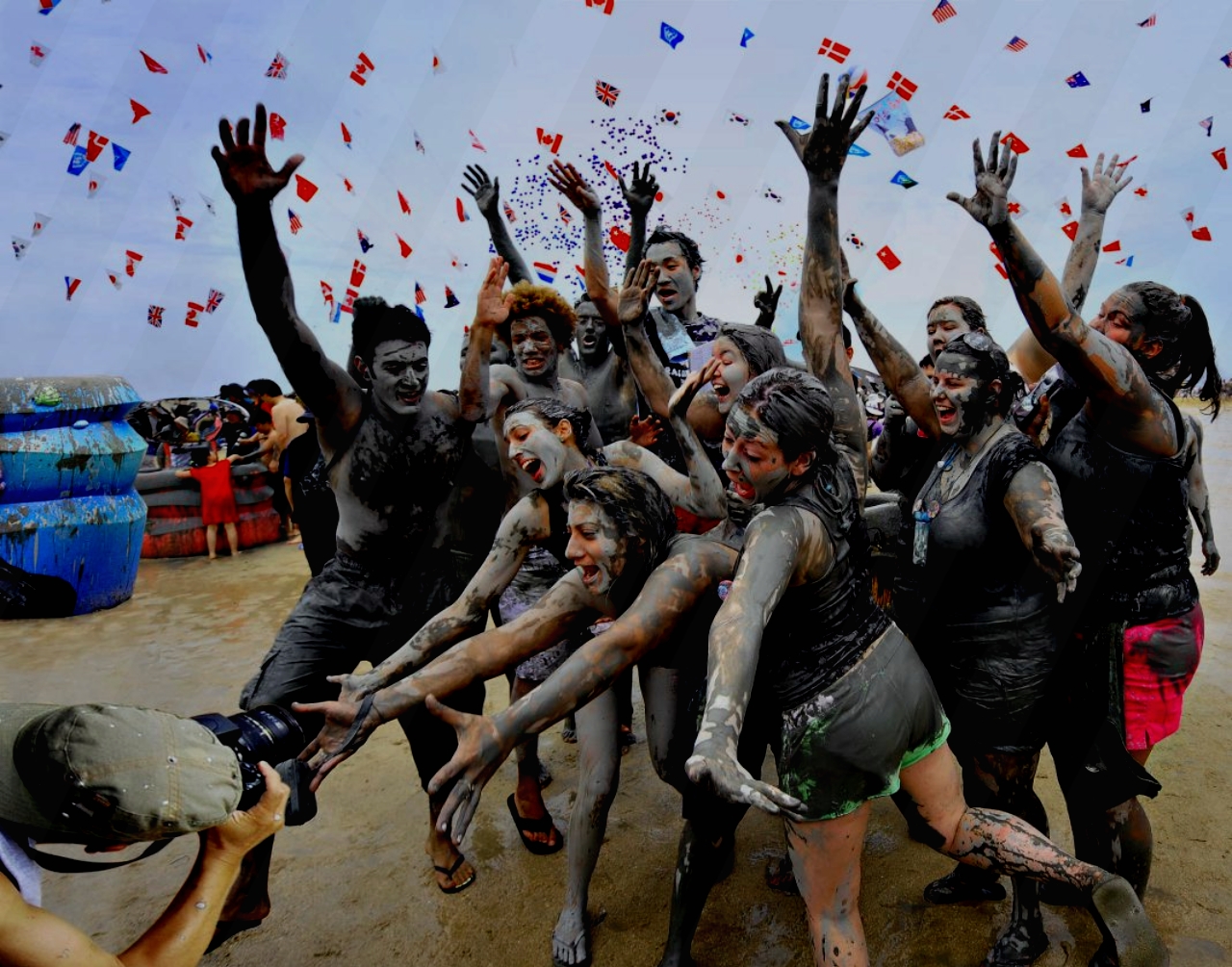
The Boryeong Mud Festival, held annually in Boryeong, South Korea, is a unique celebration that began in 1998 as a marketing effort to promote the region’s natural mud resources. What started as a local event has grown into an internationally recognized festival, attracting thousands of visitors from around the globe.
The festival takes place over several days in July on Daecheon Beach, where participants engage in a variety of activities centered around mud. The highlight of the festival is the mud pits and slides, where people of all ages can frolic and play, covering themselves from head to toe in nutrient-rich Boryeong mud. The mud is believed to have therapeutic properties for the skin, drawing crowds eager to experience its supposed health benefits.
Beyond mud wrestling and mud races, the festival also features concerts, performances, and fireworks displays, creating a vibrant and festive atmosphere. Visitors can enjoy traditional Korean foods and beverages while immersing themselves in the playful and muddy festivities.
Safety precautions are in place to ensure participants enjoy the festival responsibly, although minor injuries from slips and falls in the mud are common. The Boryeong Mud Festival is not only a fun-filled event but also a cultural celebration that showcases South Korea’s creativity and love for outdoor festivities, offering a memorable experience for locals and tourists alike.
5. Onbashira (Japan)
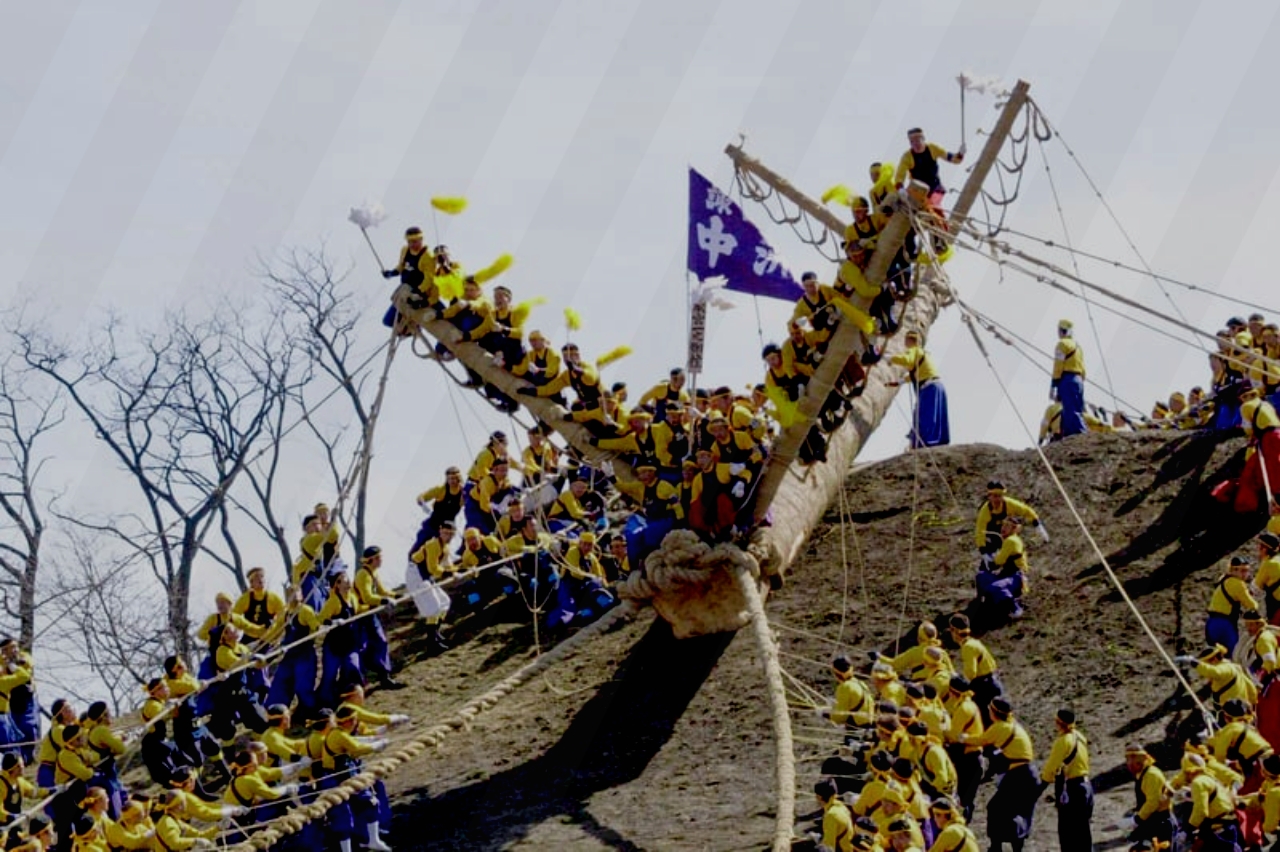
Onbashira, held every six years in the Suwa region of Nagano Prefecture, Japan, is a traditional festival that blends ancient Shinto rituals with daring feats of strength and bravery. The festival revolves around the symbolic renewal of Suwa Taisha, one of Japan’s oldest and most important Shinto shrines, through the ritual transportation and placement of massive wooden pillars known as onbashira.
The festival is divided into two main events, Yamadashi and Satobiki, each characterized by its own unique ceremonies and challenges. During Yamadashi, huge onbashira pillars, some weighing over 10 tons and reaching heights of 20 meters, are felled from the mountainside and transported downhill to the shrine through rugged terrain. This process involves hundreds of participants who ride and guide the logs using ropes, often risking their lives in the dangerous descent.
Satobiki, the second event, involves the ceremonial raising of the pillars at four corners of the Suwa Taisha shrine complex. This act symbolizes the renewal of spiritual energy and the reaffirmation of the shrine’s connection with the natural world.
Onbashira is not just a festival but a profound expression of community unity, cultural pride, and reverence for nature. It attracts spectators from across Japan and around the world who marvel at the spectacle of strength, tradition, and spiritual significance that unfolds every six years in the Suwa region.
4. Baby Jumping Festival (Spain)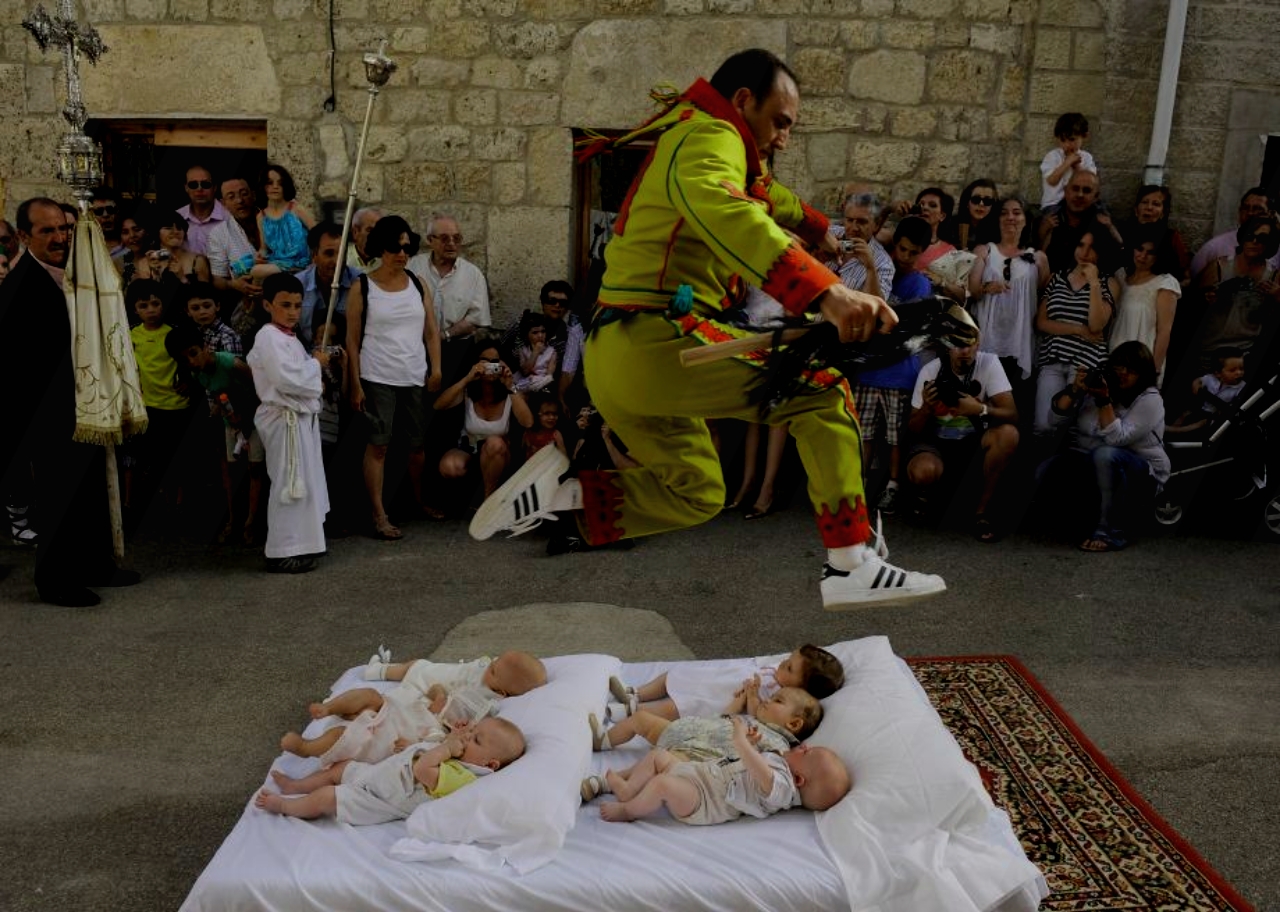
The Baby Jumping Festival, known locally as “El Colacho,” is a unique and centuries-old tradition celebrated in Castrillo de Murcia, Spain. Held annually on the Sunday after Corpus Christi, the festival combines religious devotion with daring spectacle.
During the festival, babies born in the past twelve months are laid on mattresses in the streets. A man dressed as the Devil (El Colacho) then leaps over the infants, symbolically purging them of sin and ensuring their health and prosperity. This tradition is believed to date back to the early 1600s and is rooted in Catholicism, with the goal of warding off evil spirits and protecting the babies from harm.
The festival attracts both locals and tourists who gather to witness this unusual spectacle. Parents often view El Colacho’s leap as a blessing for their children, believing it will bring good fortune and protect them from illness.
While the Baby Jumping Festival is steeped in tradition and cultural significance, safety measures are in place to ensure the infants’ well-being. Medical personnel are on standby, and strict guidelines are followed to minimize any potential risks to the babies involved.
Overall, the Baby Jumping Festival continues to captivate and intrigue visitors with its blend of religious fervor, folklore, and the unusual spectacle of watching a man dressed as the Devil leap over infants to bless them in this vibrant Spanish tradition.
3. Pamplona’s San Fermín (Spain)
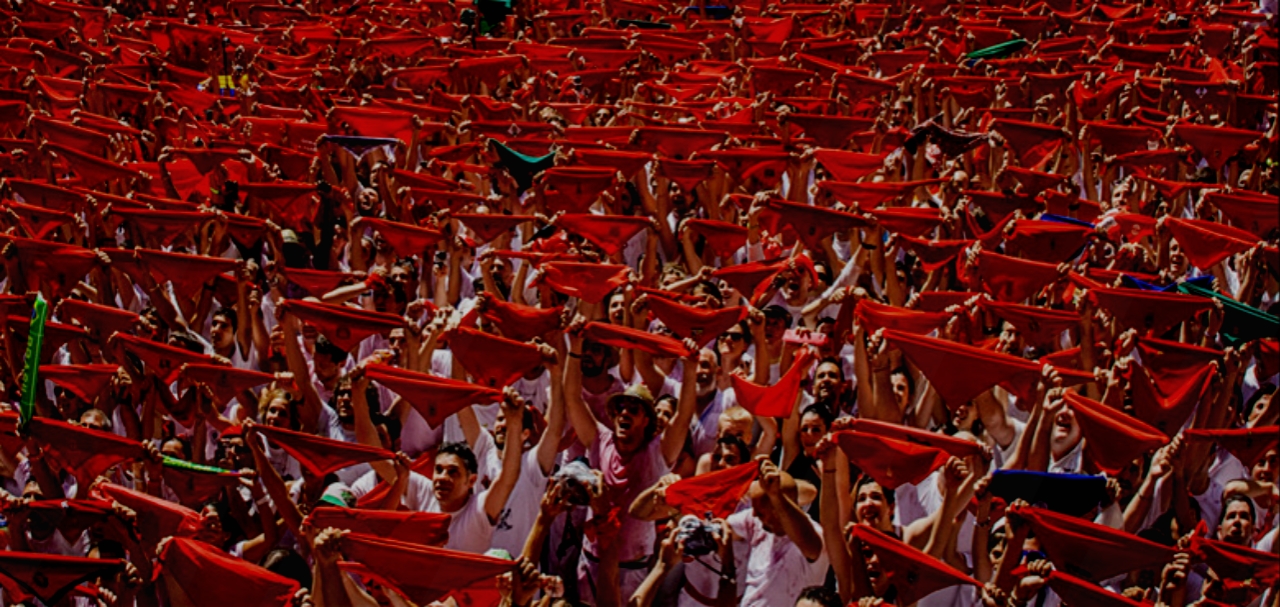
Pamplona’s San Fermín festival, famously known for the Running of the Bulls, is a week-long celebration held annually from July 6th to 14th in honor of Saint Fermín, the patron saint of Navarre, Spain. Dating back to the late 16th century, the festival has evolved into a globally recognized event that draws thousands of participants and spectators from around the world.
The highlight of San Fermín is the encierro, or Running of the Bulls, which takes place every morning at 8:00 AM. During this adrenaline-charged event, six bulls are released from their corrals to run through the narrow streets of Pamplona, accompanied by brave runners, or “mozos,” who attempt to sprint alongside them. The run covers a distance of approximately 875 meters and ends at the city’s bullring, where the bulls will later participate in bullfights.
San Fermín is also renowned for its lively atmosphere, characterized by traditional music, dance, and religious processions. Participants and spectators alike wear traditional white clothing and red scarves, symbolizing festivity and honoring Saint Fermín.
While the festival is steeped in cultural and religious significance, it also carries inherent risks. Injuries are common among runners who may fall or be gored by the bulls, despite safety measures and medical assistance provided along the route.
San Fermín remains a symbol of bravery, tradition, and communal spirit, attracting both thrill-seekers and those seeking to experience one of Spain’s most iconic cultural events firsthand.
2. Takanakuy (Peru)
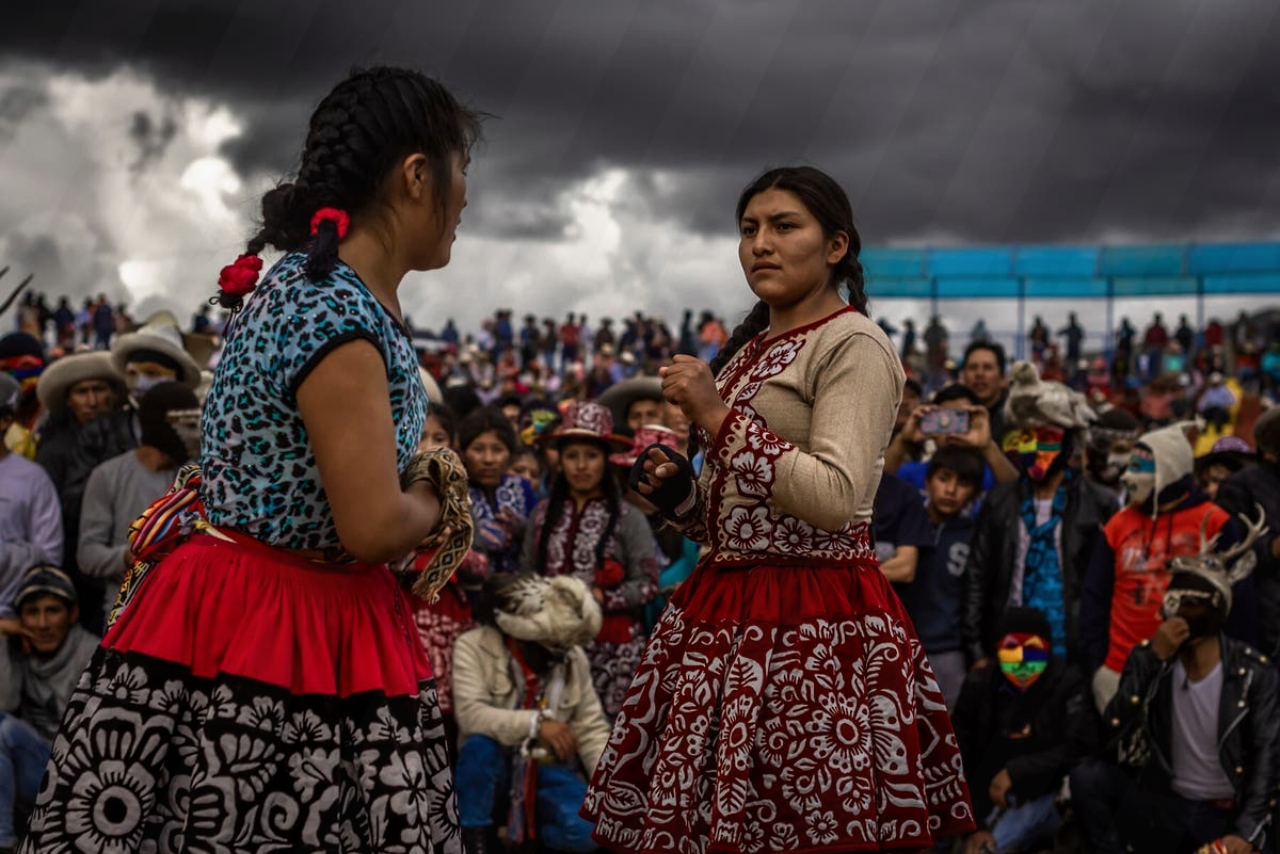
Takanakuy, a unique festival celebrated in certain regions of Peru, is an annual event that translates to “to hit each other” in Quechua, reflecting its unusual purpose: to settle grievances and resolve conflicts through physical combat. Held primarily in the Andean villages around Cusco on December 25th, Takanakuy blends indigenous traditions with Catholic influences.
During Takanakuy, participants, often dressed in colorful traditional costumes, gather in a designated arena or open space. They take turns engaging in hand-to-hand combat, where disputes that have arisen throughout the year are settled through regulated fighting. Fighters are typically matched based on age, size, and skill level, and the bouts are overseen by community elders who ensure fairness and safety.
While the festival may seem violent, it serves a deeper cultural purpose. Takanakuy allows community members to release pent-up tensions, resolve conflicts peacefully in a controlled environment, and promote unity within the community. It also reaffirms traditional values of respect, honor, and solidarity among participants.
Takanakuy has gained attention internationally for its unconventional approach to conflict resolution and its preservation of indigenous customs amidst modern influences. Despite its physical nature, the festival is marked by a spirit of reconciliation and communal support, making it a fascinating cultural phenomenon in Peru’s rich tapestry of traditions.
1. Gloucester Cheese Rolling (England)
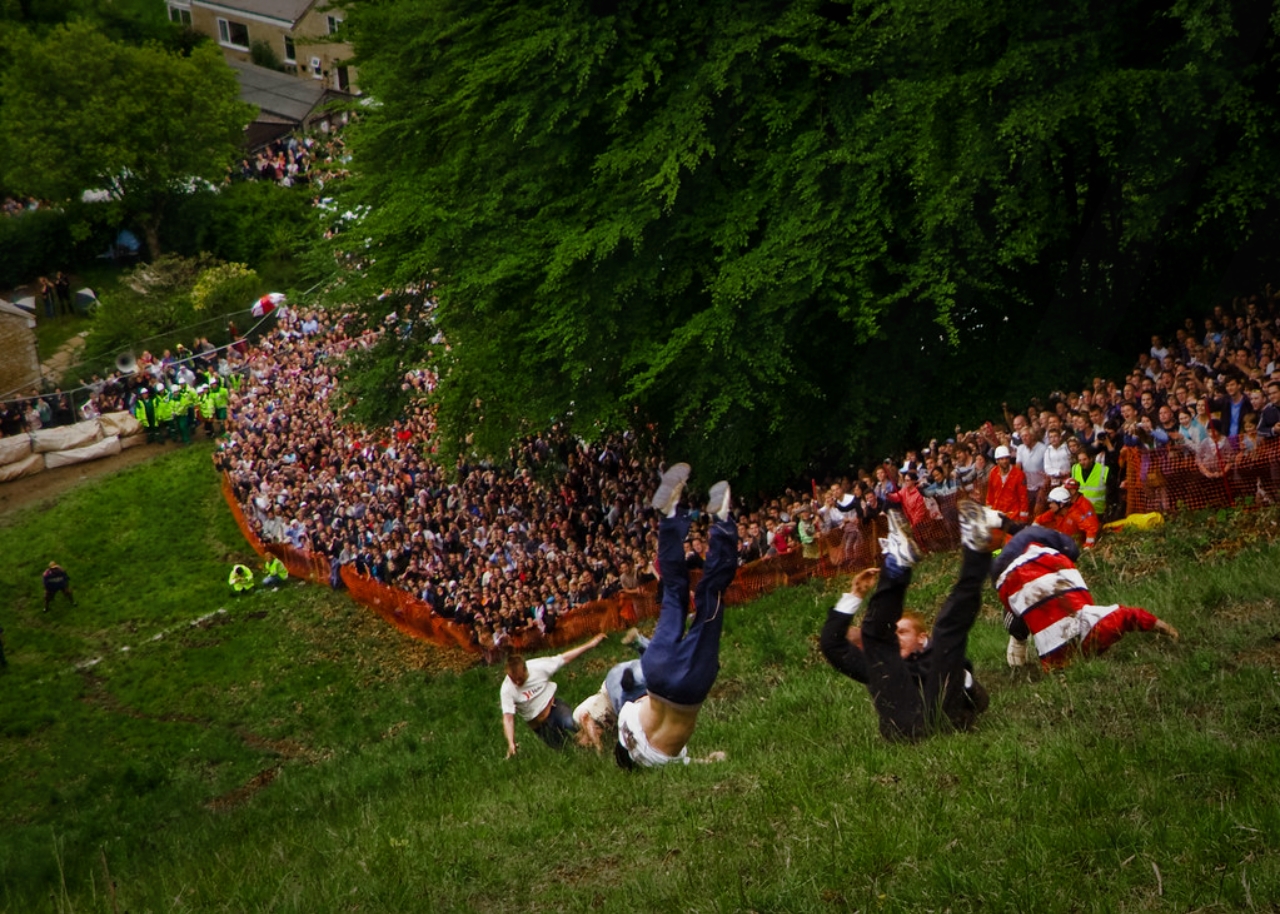
The Gloucester Cheese Rolling, held annually on Spring Bank Holiday Monday at Cooper’s Hill near Gloucester, England, is a centuries-old tradition that attracts thrill-seekers from around the world. Dating back to at least the 19th century, this quirky event involves participants chasing a round Double Gloucester cheese down the steep and treacherous slopes of Cooper’s Hill.
The cheese, weighing between seven and nine pounds, reaches speeds of up to 70 miles per hour as it bounces and tumbles down the hill. Competitors, often dressed in all manner of costumes, race after the cheese, risking injury as they navigate the uneven terrain. The objective is to catch the cheese, though this is nearly impossible given its speed and the steepness of the hill.
Safety measures are in place, and medical personnel attend to the inevitable injuries, which include sprains, bruises, and occasionally more serious injuries from falls. Despite the risks, the event continues to draw crowds of spectators and participants who revel in the adrenaline rush and the sheer spectacle of watching people tumble and chase after cheese.
The Gloucester Cheese Rolling is more than just a race; it embodies a spirit of community, tradition, and eccentricity that has endured for generations. It has become a symbol of British resilience and the willingness to embrace both tradition and the thrill of adventure in a playful and sometimes perilous manner.





